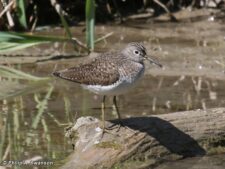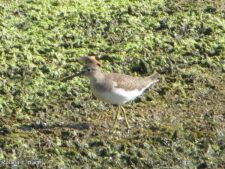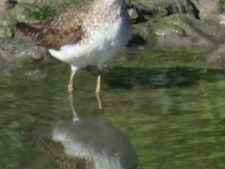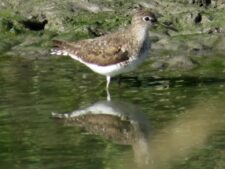
8.5 inches long. The Solitary Sandpiper is a fairly small but long-legged, slender shorebird. The head, neck, and chest are streaked with brown and white. The back and upperwings are dark olive-brown and speckled with small white spots. The rump is dark and the dark tail has black bars on the white outer feathers. The belly and throat are white. The legs are olive and there is a bold white eye ring. The base of the bill is gray to greenish-gray. In non-breeding plumage the head and neck and back are gray-brown.
The Solitary Sandpiper is a somewhat common migrant through the area. It occurs from mid April through late May and again in fall from mid July through early September. It can best be seen along Stream Trail during the spring.
The Solitary Sandpiper usually bobs its head, especially when alarmed. True to its name it is usually solitary in migration in contrast to most other shorebirds. It searches for food by stirring up the water. Its flight is swallow-like. It holds its wings straight up when landing after flight and then slowly closes them. It nests in remote northern bogs, laying its eggs in the tree nests. The call is a high pitched “pit-peet-wheet” or just “peet”.
Disclaimer: The content of NatureSearch is provided by dedicated volunteer Naturalists of Fontenelle Forest who strive to provide the most accurate information available. Contributors of the images retain their copyrights. The point of contact for this page is: Phil Swanson.





